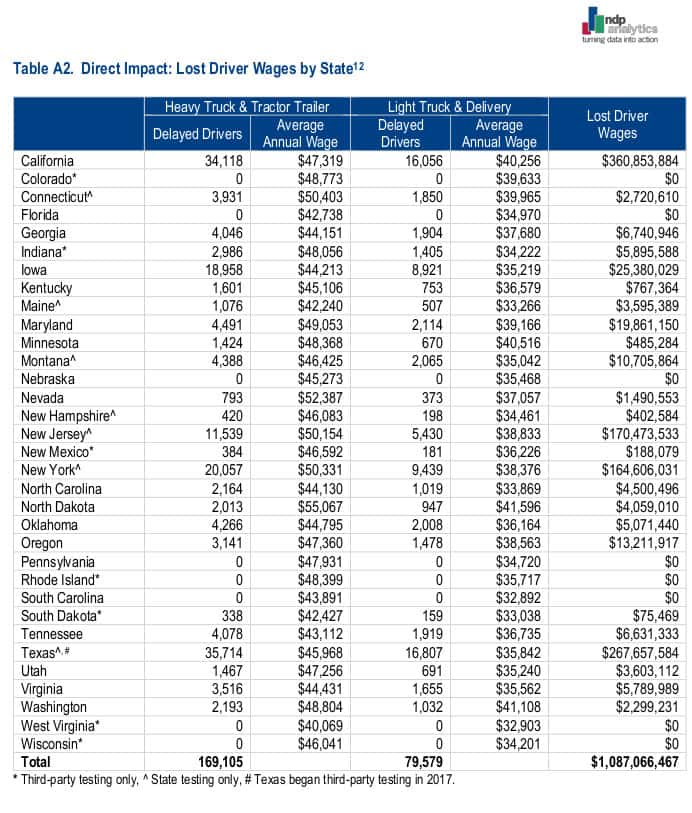Last fall, the Federal Motor Carrier Safety Administration (FMCSA) made public the results of a survey that showed no wait times, beyond a 14-day federal and various state-mandated wait times, for new truck drivers taking their behind-the-wheel skills test to obtain a commercial driver’s license (CDL) in the majority of states.
The survey, though, was not complete, according to critics, who say its findings lacked context and relied on states to self-report. Some states didn’t respond (FMCSA received responses from only 46 states), and of those that did, “two states provided only general comments, one state provided data from a few of its test locations, two states provided detailed information on each segment of the CDL skills test, while the remaining 41 states provided the majority of information requested,” FMCSA wrote in the report.
Students must pass a written test and then wait the federally mandated 14 days before taking a skills test in all states before obtaining a CDL. In some states, though, scheduling that test can take weeks, if not months.
The Commercial Vehicle Training Association (CVTA), which represents commercial truck driver training programs in the U.S., wasn’t convinced the report accurately represented the problems that delays in testing cause. FMCSA found that in 30 states there was no delay in scheduling a test, but in the remaining 16 states that responded to the survey, delays ranged from one day in Arkansas and Minnesota up to 47 days in New Jersey. However, as Don Lefeve, president and CEO of CVTA, told FreightWaves, for students who must retake a failed test, as 29 percent do, that wait time can extend several more weeks.
To help put the FMCSA survey in context, CVTA commissioned an economic impact study to find out what testing delays were actually costing society.
“Now that we have this data, what does it mean?” Lefeve asked. “Certainly, there are instances where people say, ‘I can’t afford to wait for the test, I have to go back and get a job,’ and our schools have seen that.”
FMCSA found that states deployed a mix of testing methods, from state-administered tests to third-party testing programs to a combination of both. What Lefeve and CVTA were most interested in was the impact third-party testing had on wait times.
“If you look at states that don’t have wait times, they typically are utilizing third-party testing, and states with longer wait times are [generally] not,” Lefeve said.
 (Chart: ndp | analytics)
(Chart: ndp | analytics)
Lefeve pointed to Florida and California as examples. Florida administered more CDL tests than California but had no wait time compared to the Golden State’s 23 days. The reason, Lefeve said, is that Florida has 200 locations capable of administering the test while California has just 23.
To ease wait times, CVTA is pushing for more states to allow third-party testing. Lefeve said the tests are the same and test administrators are put through the same training programs and audited the same way state employees are, so there is no safety argument to be made against it. However, FMCSA has no authority to force states to offer third-party testing, so it is up to each state.
“The real problem is the way it impacts students,” Lefeve said. “You wait six weeks to take a test, and then you fail, and now you have to wait another six weeks to get tested again. There is a better way to do this and there is a best practice, and 24 states do this very well.”
CVTA turned to ndp | analytics to quantify the problem. The research firm studied 33 states and estimated that 49 percent of all CDL skills tests and retests involved delays in 2016, totaling over 6.4 million days of delays.
“These delays put 258,744 driver and other jobs on hold and forgo nearly $1.5 billion in wages a year,” the firm said. “If skills tests and income were not delayed, local economies could have added nearly $1.4 billion in economic activities and federal and local governments could have collected an additional $342 million in income and sales tax revenue. The majority of these losses occur in states with a state-only [testing] system.”
 (Chart: ndp | analytics)
(Chart: ndp | analytics)
The consulting firm added that states with third-party administrators had no waiting time for the initial test and under two days for a retest, compared to 12 days and 17 days for those states with state-only testing. In states with third-party-only testing, only 3,709 heavy truck and tractor-trailer drivers experienced delays in testing. That number rose to 88,270 in states with both and 77,126 in states with no third-party testing.
Further, the delays resulted in lost driver wages of $1.1 billion, based on Bureau of Labor Statistics data for mean wages, for an average of $160 per day while a driver waits to take the test. On a wider scale, ndp | analytics determined that those lost wages added $401 million more in lost opportunity for other workers who would have been supported by the spending habits of the drivers. Using Tax Foundation methodology, that lost driver income denied federal, state and local governments an additional $342 million in tax revenue.
“I think this is a national problem and I think what this report shows is there is a negative effect — $1.5 billion in lost wages — for commercial drivers,” Lefeve said. “That has an impact on interstate commerce, and because of that impact on interstate commerce, Congress has the ability to [legislate it].”
Lefeve hopes Congress will act on legislation introduced in the House last year to require states to have wait times of no longer than seven days.
“We are working on getting that re-introduced,” he said.










